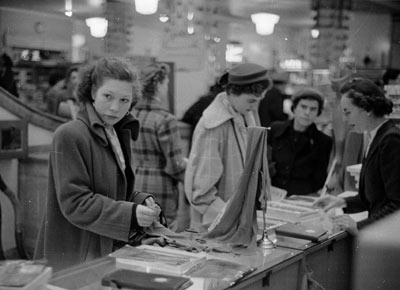How Anti-shoplifting Devices Work (2)

A shoplifter looks around a department store to check if anyone is watching her
The first option in loss prevention involves the use of deterrents such as security guards, observation mirrors (that allow store clerks to see throughout the store) and closed-circuit television (CCTV) surveillance systems. Most large stores use some combination of these techniques, which were among the earliest tools used to combat shoplifting. Smaller businesses, unable to afford security guards, were able to install video cameras — usually in a prominent place so that shoppers knew they were being watched — to record activity in the store. Later, the retailer could review the tapes, observe shoppers behaving suspiciously (sometimes even stealing) and note the vulnerable displays or areas in the store. The problem with this record-and-review system is that some shoplifters get away with stealing. On the other hand, experts say, the system has merit in that it allows for possible recognition of repeat offenders (something that is prevalent among shoplifters). By reviewing these tapes, the store owner can also learn about theft patterns and get ideas about ways to deal with them.
Your imaginary department store would probably use electronic surveillance a bit differently than smaller businesses. You might have security staff monitoring store activity on closed-circuit TV as it happens in an effort to prevent shoplifting. Today, there are even systems that allow retailers with several locations to monitor stores and distribution centers from a single location. These remote surveillance systems allow users to send full-frame video image streams over high-speed phone lines to other locations and to electronically store digital video images for review or evidence.
And in larger stores, cameras are often less visible. Next time you’re in your favorite department store, look around. High-speed, high-resolution digital cameras may be mounted in smoke detectors, sprinkler heads, thermostats or clocks. (It’s popular to mount cameras in ceiling tile domes (they’re bubble-like and tinted so no one can see where the camera is pointed). From this vantage point, a pan/tilt/zoom camera can swing about and follow someone around the store. (If security is not monitoring and operating the camera, it can be set up to pan automatically but will not follow someone around the store.)
Video cameras used for security purposes don’t look anything like the video camera your family has at home — they’re becoming smaller and more specialized. A standard surveillance camera might be in the neighborhood of 4 inches long by 2 1/2 inches wide with a lens on the end, according to Jeff Bates of ADT Security Systems in Raleigh, N.C. A hidden camera might be a board camera, which basically is a 1 inch by 1 inch square computer board with a tiny lens, perhaps 1/4 inch in size. These cameras are designed to two specifications, experts say: they must be small and easy to hide.
Now for option number two: locking things up nice and tight. Cable, wire products and security bars are also familiar types of retail security devices. They certainly work to keep your merchandise in the store. But retail industry experts say this isn’t the best way to move your products because cables and other locking devices make it difficult for people to examine items and try on garments. Customers have to get a clerk to come release the item so they can try it on or look at it. Since most people are in a hurry, this might motivate shoppers to move on to a store where the merchandise is more accessible.
Having said that, if you need to use security cables and locking racks, there’s a wide variety of products available to you. Security cables are made with a variety of properties: coaxial cables (for CCTV systems), alarm cables and fiber optic cables. Wire lanyards, which can be snaked through a garment to attach it to a rack or display, are being made stronger all the time. For example, Retail Security Products offers to send potential customers a lanyard test kit to illustrate the strength — over 250 pounds in a pull test — of their product. You’ve probably also seen the locked steel racks used for expensive coats and jackets — again, these have to be unlocked by a sales clerk.
